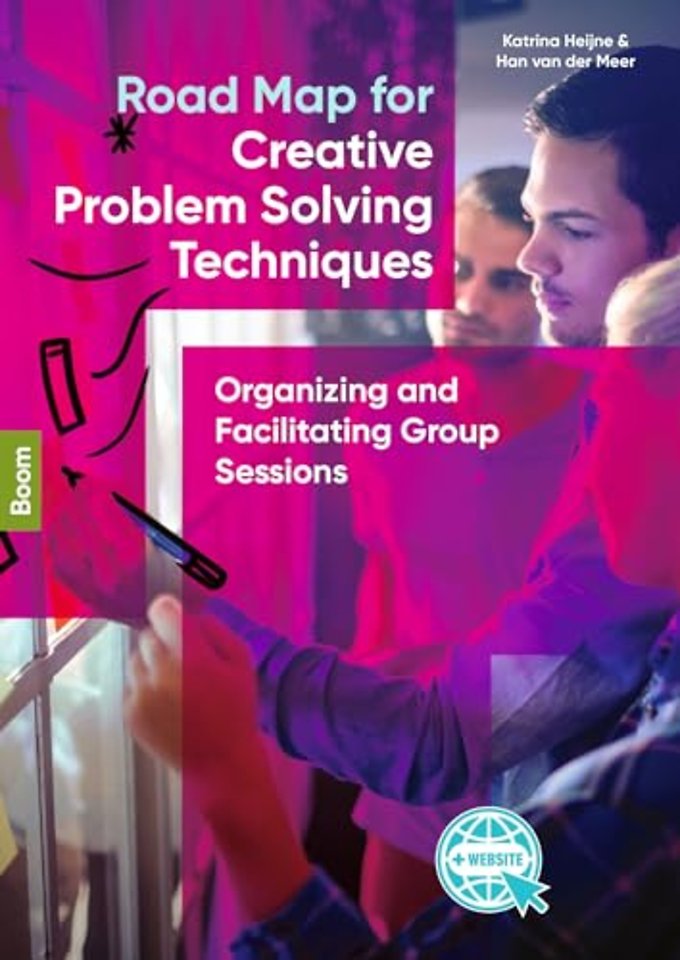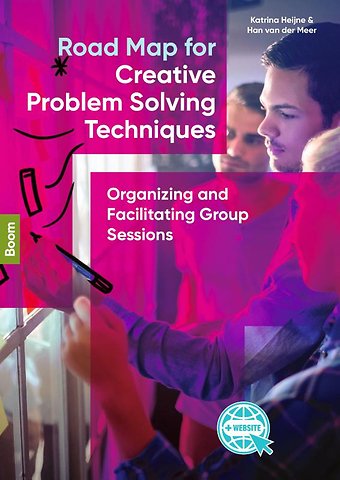


Katrina Heijne (1985) is docent Creative Facilitation aan de TUDelft en oprichter van het bureau Serious Creativity.
Meer over de auteursRoad Map for Creative Problem Solving Techniques
Organizing and facilitating group sessions
Paperback Engels 2019 1e druk 9789024401116Samenvatting
Creativity is one of the vital 21st century skills. As the subject of a large academic and practitioner community since 1950, there are literally hundreds of books and thousands of techniques on creativity.
In this book, this body of knowledge is boiled down for modern scholars and facilitators to one framework called iCPS, integrated Creative Problem Solving. For the techniques, the book focuses on techniques for groups and details 40 essential ones. This is the main part of the book. The set of 40 covers all the techniques in the field and offers the building blocks to construct group sessions. Guidelines for organizing sessions will help the reader position the building blocks and make the design for a smooth process. The website will offer even more details and practicalities to run magic sessions and courses.
Trefwoorden
creativiteit probleemoplossing groepssessies icps faciliteren brainstormen revergeren convergeren divergeren creatieve technieken facilitatie creative diamond innovatie workshopleiding brainwriting excursietechnieken analogieën ideeëngeneratie groepsdynamiek scamper mindmapping morfologische synthese triz ideeselectie lateral thinking force field analysis criteria ranking idea gallery elevator pitch delft design methode
Trefwoorden
Specificaties
Lezersrecensies
Over Han van der Meer
Inhoudsopgave
U kunt van deze inhoudsopgave een PDF downloaden
1 Setting the stage 1
1.1 Historical overview of creativity 1
1.2 iCPS: Delft’s expansion of the traditional CPS approach 6
1.2.1 The four sub-processes of iCPS 6
1.2.2 Creative diamond 2.0 8
1.2.3 iCPS basic module 11
1.2.4 The active role of the facilitator in both process and content 12
1.3 The three basic principles for good facilitation 12
1.3.1 Principle 1: Role rigidity 12
1.3.2 Principle 2: Clear problem statement 14
1.3.3 Principle 3: Rules and techniques for each step of the creative diamond 14
1.4 Rules and techniques for diverging 14
1.4.1 Divergent mindset: Postpone judgment 15
1.4.2 The first rule of diverging: Quantity breeds quality 16
1.4.3 The second rule of diverging: Hitchhike 18
1.4.4 The third rule of diverging: Freewheel 18
1.5 Rules and techniques for reverging 19
1.5.1 The revergent mindset: Use the inquiring mind 20
1.5.2 The first rule of reverging: Be jointly active 20
1.5.3 The second rule of reverging: Listen responsively 21
1.5.4 The third rule of reverging: Move circularly 21
1.6 Rules and techniques for converging 21
1.6.1 Convergent mindset: Affirmative judgment 22
1.6.2 The first rule of converging: Protect originality 22
1.6.3 The second rule of converging: Trust the hedonic response 23
1.6.4 The third rule of converging: Have action in mind 23
1.7 To conclude 24
2 ‘Road Map’ and Technique Selection Chart 25
2.1 iCPS techniques categorized 26
2.1.1 The chapter structure 26
2.1.2 The 3-diamond overview 27
2.1.3 Technique Selection Chart 31
2.2 Lay-out of iCPS techniques 34
3 Delft Road Map for Creative Problem Solving Techniques 37
3.1 Content Finding – Diverging 39
3.1.1 Brainstorming (traditional) 40
3.1.2 Brainwriting with Post-its® 44
3.1.3 Brainwriting 6.3.5 48
3.1.4 Creative Confrontation (excursion & forced fit) 52
3.1.5 Excursion 1: Criminal Round 56
3.1.6 Excursion 2: Take a Walk 60
3.1.7 Excursion 3: Hidden Presumptions 64
3.1.8 Excursion 4: Absurd Questioning 68
3.1.9 Excursion 5: Random Words 72
3.1.10 Excursion 6: Random Objects 76
3.1.11 Excursion 7: Visual Stimulation 80
3.1.12 Excursion 8: Guided Fantasy 84
3.1.13 Excursion 9: Personal Analogy 88
3.1.14 Excursion 10: Direct Analogy or Metaphor 92
3.1.15 Excursion 11: Symbolic and Fantasy Analogy 96
3.1.16 Flower Association 100
3.1.17 How To’s or H2’s 104
3.1.18 Interactive Brainsketching 108
3.1.19 Ladder of Abstraction 112
3.1.20 Making a Collage 116
3.1.21 MATEC 120
3.1.22 Mind Mapping in a Group Session 124
3.1.23 Morphological Synthesis 128
3.1.24 Picture the Problem 132
3.1.25 SCAMPER 136
3.1.26 40 Inventive Principles of TRIZ 140
3.1.27 5W1H 144
3.2 Content Finding – Reverging 149
3.2.1 Idea Gallery 150
3.2.2 Elevator Pitch 154
3.2.3 Spontaneous Clustering 158
3.2.4 Sequencing 162
3.3 Content Finding – Converging 169
3.3.1 Restating the Problem 170
3.3.2 Hits or Dots 174
3.3.3 Paired Comparison 178
3.3.4 Criteria & Ranking 182
3.3.5 UALo 186
3.3.6 Making a Poster 192
3.4 Acceptance Finding 197
3.4.1 Devil’s and Angel’s Advocates 198
3.4.2 Force Field Analysis 202
3.5 Information Finding 209
3.5.1 Parking Lot 210
4 Guidelines for Organizing the Session 215
4.1 Conditions for using iCPS 216
4.2 Prepare and organize 217
4.2.1 Intake with the problem owner 217
4.2.2 Gear up 222
4.2.3 Anticipate follow-up 230
4.3 Session duties 232
4.3.1 Session duty 1: Welcome & introduction 234
4.3.2 Session duty 2: Briefing by the problem owner 238
4.3.3 Session duty 3: Purge 240
4.3.4 Session duty 4: SPARK the PaP 244
4.3.5 Session duty 5: Icebreakers 248
4.3.6 Session duty 6: Energizers 252
4.3.7 Session duty 7: Break 258
4.3.8 Session duty 8: Wrap-up & closing 262
5 Case Examples 267
5.1 Case 1 – Single and short: Smoke-free 267
5.2 Case 2 – Complex and Long: The New Brewery 270
5.3 Case 3 – Complex and Very Long: U_CODE, a new tool for Urban Design 272
6 Epilogue 275
7 References 277
8 Glossary 285
9 Image credits 293
10 Index 295
11 About the authors 297
Technique Selection Chart 300
Vergelijkbare boeken
Anderen die dit boek kochten, kochten ook
Rubrieken
- advisering
- algemeen management
- coaching en trainen
- communicatie en media
- economie
- financieel management
- inkoop en logistiek
- internet en social media
- it-management / ict
- juridisch
- leiderschap
- marketing
- mens en maatschappij
- non-profit
- ondernemen
- organisatiekunde
- personal finance
- personeelsmanagement
- persoonlijke effectiviteit
- projectmanagement
- psychologie
- reclame en verkoop
- strategisch management
- verandermanagement
- werk en loopbaan











